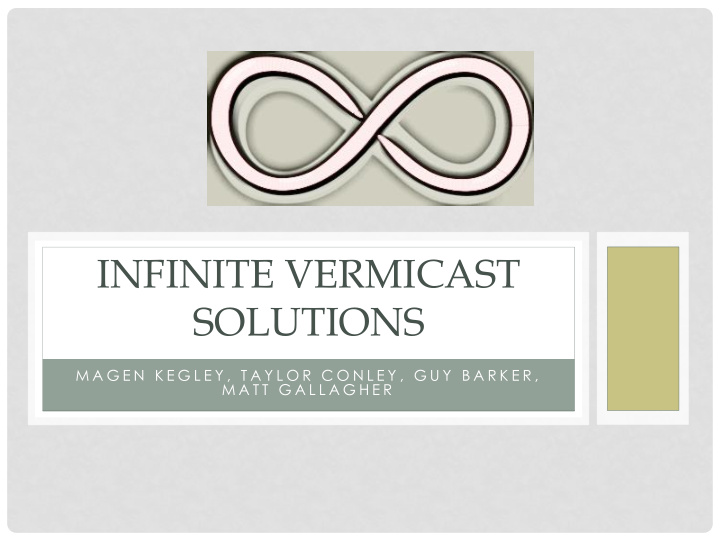



INFINITE VERMICAST SOLUTIONS M A G E N K E G L E Y , T A Y L O R C O N L E Y , G U Y B A R K E R , M A T T G A L L A G H E R
ABOUT THE CLIENT • Dale Robinson • Inventor of The Big Squeegee • http://www.bigsqueegee.com • Runs business out of Lawton, OK • Looking to innovate vermicomposting systems by making them continuous Bigsqueegee.com
WHAT’S THE PROBLEM? Decreasing number of landfills since 1988 Source: Municipal Solid Waste Generation, Recycling, and Disposal in the United States: Facts and Figures for 2005, EPA, page 14) .
LANDFILLS • According to the EPA, America produces 254 million tons of trash a year.
LANDFILL COMPOSITION http://cdn.theatlantic.com
STATISTICS • Every year, 40% of the food generated by Americans is wasted. (https://www.nrdc.org/food) • 34 million tons of food scraps • Historically, food scraps were separated from garbage and used as pig food, but today it ends up in the trash. https://www.google.com/search?q=landfills
SOLUTION • Composting Large amounts of organic waste can be turned into nutrient-rich substance capable of repurpose. https://www.google.com/search?q=comp https://www.google.com/search?q=compost ost+pile&
COMPOSTING • Typically the organic material is decomposed using microorganisms • However, there is a faster way- Vermicomposting
BACKGROUND • ver· mi· com· post· ing [ ˌ v ə rm əˈ kämpōstiNG ] NOUN , the use of earthworms to convert organic waste into fertilizer. Vermicomposting." Oxford University Press, n.d. Web. 6 Nov. 2015. • • Vermicomposting is an effective and beneficial way to reduce the amount of trash that is being dumped into landfills every day
OBJECTIVES • Create a continuous, flow-through vermicast system • Worm excretions are a useful form of topsoil and fertilizer that can grow better food • Design will be small enough for an “everyday” person to use
SCOPE • Design is expected to deliver food to flow through system • Best species of worm will be determined from research • Data on worm doubling time and food consumption will be taken
TASKS • Our main task will be the construction of the flow- through bin • Worms must consume a certain amount of food before tests can be done on the flow-through bin • A “food spraying” implement will be designed and constructed as the food delivery system for the worms
WORK BREAKDOWN STRUCTURE
DESIGN CONSIDERATIONS: FLATBED • Flatbed “box” system • Blade runs back and forth across box and scrapes castings off
FLATBED PROS • Effective flow-through system • Used by many large-scale industrial vermicomposting systems • Large surface area provides more room for worm volume
FLATBED CONS • Difficult to fit into small, domestic settings • Laterally moving blades require more power • More problematic to evenly distribute compost • Larger amounts of water needed for more surface area
DESIGN CONSIDERATIONS: MANUALLY FED CYLINDER • Cylindrical column where food and water are added together • As worms digest compost, castings move to the bottom • Employs “flow - through” design • Currently widely used as a domestic design for vermicomposting
MANUALLY FED CYLINDER PROS • Good size for every-day households • Flow-through system • Easy to control parameters
MANUALLY FED CYLINDER CONS • Manual removal of castings • Food not pre-digested takes longer to process into castings • Increases chances of anaerobic digestion by microbes • Food and water added separately = more work
SECURITY • Secure and private work and construction environment • Unaltered ambient conditions for worms to ensure proper data collection • Protection of public from potentially hazardous parts • Usage of non-invasive worm species
BAE 1012 CONTRIBUTIONS • Research on species physiology and ideal conditions for vermicomposting • Research on mechanical specifications of hydroseeder sprayers and ideal material composition of semi-solid spraying
DELIVERY • The final product must be a sustainable, continuous, flow-through bin that digests and delivers food to worms • Research on why the specific worm species that was chosen will also be presented • Doubling time and food consumption will demonstrate efficiency of system
WORM BIN DESIGN CONSIDERATIONS • Marry efficiencies of flat bed & fed cylinder • Increase efficiency spatial use • Increase bin depth • For gestation & curing period of eggs & castings • Produce an immediately usable product • Eliminate the need for propagation trays or worm harvesters Jet 3600 series worm harvester
INITIAL DESIGN
HYDROFEEDER DESIGN CONSIDERATIONS • Increase Loading efficiency and cut down on man power • Avoid loading bins by • Hand • Small commercial equipment (skid-steer) • Combine the feed and moisture control system • While maintaining appropriate DO (dissolved oxygen) levels
INITIAL DESIGN OF HYDROFEEDER
VERMICULTURE • Worms chosen were Red Wigglers • Optimal growth temperature between 55-77°F (13- 25°C) • Bed depth will be around 6- 10” • Aerobic environment required • Expected to live 2-3 years
FOOD FOR VERMICULTURE • Cellulosic material will be used to feed worms • Newspapers, fruits and vegetables, coffee grounds, and “coco - coir” will be used as feedstock • Ammonia-rich compounds (manure and urine) needs pre-treatment • Expected to eat their weight in food • Pre-digested food aids in casting-producing efficiency
DEALING WITH POPULATION GROWTH • Doubling time of Red Wigglers expected to be 60 days • Over time, worms will reach “critical mass” • Manual harvesting of worms to continue growth • Use as bait or feed – provide extra business • Considered a “maintenance” aspect of the system
COMPOST THAT CAN NOT BE USED • Dairy products and meats • Non-biodegradable products (plastics) • Cat litter • Non-treated manure and urine
PERFORMANCE • Duties already performed: • Research of vermiculture and worm physiology • SolidWorks drawing of potential system design • Duties to be carried out: • Order parts and materials for bin construction • System set-up and construction • Fill bin/bed with compost and worms • Test system with digester and food sprayer • Collect necessary data
Recommend
More recommend